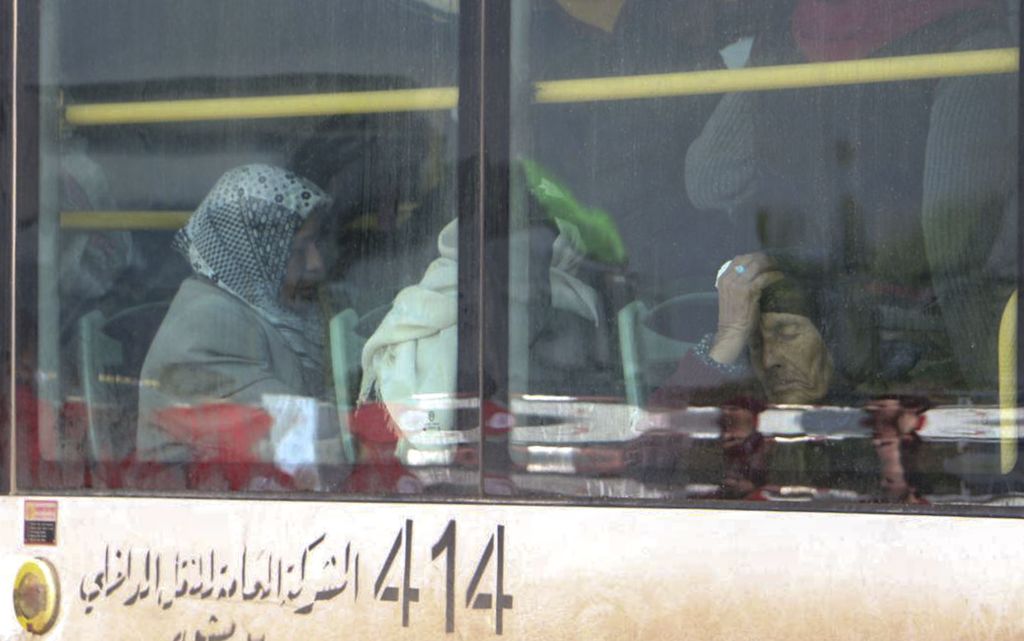BEIRUT – The Syrian government and rebels began a co-ordinated population transfer Friday of about 10,000 people from four towns besieged for years amid the country’s bloody, six-year civil war.

About 5,000 people were evacuated on 75 buses from two pro-government towns in northern Syria to the nearby city of Aleppo, said Abdul Hakim Baghdadi, who helped negotiate the arrangement.
The predominantly Shiite Foua and Kfraya have remained loyal to the Syrian government while the surrounding Idlib province has come under hard-line Sunni, rebel rule.
READ MORE: Bashar Assad dismisses Syria chemical attack as ‘100% fabrication’
Near the capital of Damascus, some 60 buses carrying 2,350 opposition fighters, activists and their families departed from two opposition-held towns in the direction of Idlib, according to the Britain-based Syrian Observatory for Human Rights monitoring group and Syrian state media.
If the evacuations are completed, they would be the first in number of rounds stretching over two months to evacuate some 30,000 Syrians from besieged areas. Another 3,000 people are expected to be bused out of Foua and Kfraya on Friday evening, according to Baghdadi.
WATCH: U.S.-Russia relations at ‘low point’ over Syria

Madaya and Zabadani are the latest in a constellation of towns once held by the opposition around Damascus to submit to government rule. Pro-government forces have held the two towns under twin sieges for nearly two years, leading residents to hunt rodents and boil grass to stave off hunger in the winter months. Photos of children gaunt with hunger shocked the world and gave new urgency to U.N. relief operations in Syria.
“We’ve moved. We’re at the outskirts of the towns,” said Muhammad Darwish, who provides medical care in Madaya. He was forced to leave his university in the final year of his dentistry studies when he joined the popular movement to unseat President Bashar Assad six years ago. The country has since descended into a harsh civil war.
Critics have denounced the deal as the forced rearrangement of the country’s population, and the United Nations is not supervising the evacuations.
In Madaya, residents were given the option to stay and “reconcile” their status with government authorities. They will have to pledge allegiance to President Assad’s government and swear off any dissent. Military defectors, draft-dodgers and reservists called up for duty will have between six months to a year to return to the armed services, or to apply for an exemption. Most of the estimated 40,000 residents will stay and accept the terms.
But at least 2,000 will not, according to Darwish. They include former fighters, activists and medical workers who say they cannot redeploy with the military that once shelled their homes, and who are wary of the treatment they will receive at the hands of the government’s notorious security services.
READ MORE: U.S. missile strike on Syria: Here’s what we know so far
“I can’t stay,” Darwish told The Associated Press when it became clear the evacuations would occur. The government has targeted medical workers with detention, torture and bombardment throughout the conflict, according to local medical workers, as well as reports from Physicians for Human Rights and Doctors Without Borders.
“It’s more dangerous for a doctor than it is for a fighter to stay,” he said.
Similar offers were extended to other areas that have surrendered to the government, including Moadamiyeh, Hameh, Qudsaya and the Barada Valley around the capital, and formerly rebellious neighbourhoods in Aleppo and Homs, Syria’s first and third largest cities, respectively.
READ MORE: Trudeau’s stance on Syria shows he is keen to stay in Trump’s favour: expert
Zabadani, however, is to be depopulated. The arrangement has the town’s last 160 hold outs — all believed to be fighters or medical workers — bussed out. In doing so, it faces a similar fate to the much larger Darayya, another Damascus suburb, which was depopulated following years of crushing government siege and bombardment last August.
Most of eastern Aleppo was depopulated through force, as well. A U.N. inquiry said the evacuation of east Aleppo amounted to a war crime because it was coerced through the joint Russian and Syrian government campaign against the city’s civilian infrastructure. More than 20,000 people were bussed out of Aleppo at the end of last year, to rebel-held provinces in the northwest.
Overall, tens of thousands of people have been uprooted to Idlib and Aleppo province, where they fear they are being gathered for a final government offensive to defeat them all.
Amer Burhan, the director for Zabadani’s field hospital, said he expects the young fighters in Zabadani to join the fronts in northern Syria to fight the government some more.
The fates of Fuoua and Kfraya are less clear. Baghdadi, the negotiator, says conscripts will stay and fight to defend the towns. But Yasser Abdelatif, a media official for the ultraconservative rebel group Ahrar al-Sham, said the towns will be depopulated completely.
The evacuation deal brokered by Qatar, negotiating on behalf of the rebels, and Iran, on behalf of the government, in March.



Comments